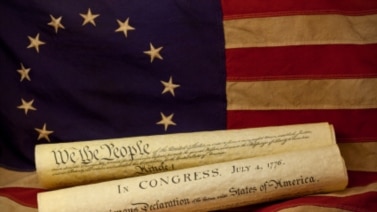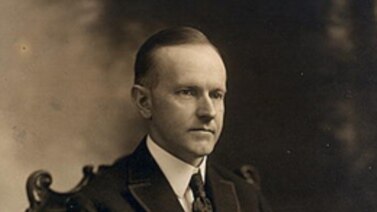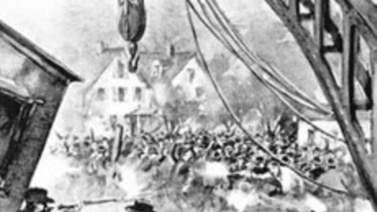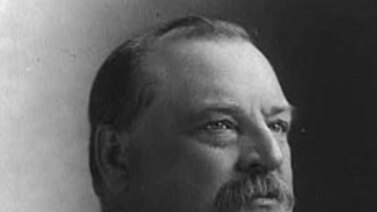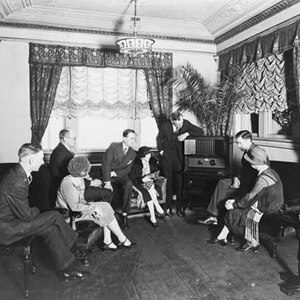
MARIO RITTER: Welcome to THE MAKING OF A NATION -- American history in VOA Special English.
The years after World War One were an important turning point in the making of the American nation. The country turned away from the problems of Europe. Now it would deal with problems of its own.
This week in our series, Kay Gallant and MAURICE JOYCE: tell about the many changes in America during the early nineteen twenties.
KAY GALLANT: There was a presidential election in America in nineteen twenty. President Woodrow Wilson was not a candidate. He had suffered a stroke and was too sick. The two major candidates were Democrat James Cox and Republican Warren Harding. Voters had a clear choice between the two candidates.
Cox supported the ideas of President Wilson. He believed the United States should take an active part in world affairs. Harding opposed the idea of internationalism. He believed the United States should worry only about events within its own borders.
Warren Harding won the election. By their votes, Americans made clear they were tired of sacrificing lives and money to solve other people's problems. They just wanted to live their own lives and make their own country a better place.
MAURICE JOYCE: This was a great change in the nation's thinking. For twenty years, since the beginning of the century, the United States had become more involved in international events.
Young Americans had grown up with presidents like Woodrow Wilson and Theodore Roosevelt. Both Wilson and Roosevelt had active foreign policies. Both helped start the nation on the road to becoming a major world power.
Then came World War One. It was like a sharp needle that bursts a balloon. The United States and the Allies won the war against Germany and the Central Powers. But thousands of American troops had died in the European conflict. And many months were taken up by the bitter debate over the peace treaty and the League of Nations.
Most Americans did not want to hear about Europe and international peace organizations any more.
KAY GALLANT: Instead, Americans became more concerned with material things. During World War One, they had lived under many kinds of restrictions. The federal government had controlled railroads, shipping, and industrial production. At the end of the war, these controls were lifted. Industries that had been making war supplies began making products for a peacetime economy.
Wages for most workers in the United States were higher than ever at the beginning of the nineteen twenties. Men and women had enough money to enjoy life more than they had in the past.
(MUSIC)
MAURICE JOYCE: Technology made it possible for millions of people to improve their lives. It also caused great changes in American society. Two of the most important new technologies were automobiles and radio.
In the early years of the twentieth century, automobiles were very costly. Each one was built separately by a small team of skilled workers. Most Americans did not have the money to own an automobile.
Then Henry Ford decided to make cars everyone could buy. He built them on an assembly line. Cars were put together, or assembled, as they moved slowly through the factory. Each worker did just one thing to the car before it moved on to the next worker. In this way, the Ford Motor Company could build cars more quickly and easily. And it could sell them for much less money.
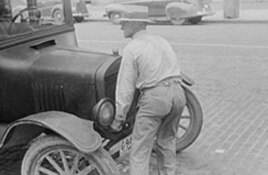
KAY GALLANT: Before long, there were cars everywhere. All these cars created a need for better roads. Outside cities, most roads were made just of dirt. They were chokingly dusty in dry weather and impassably muddy in the rain.
They were rough and full of holes. Few bridges connected roads across rivers and streams. America's new drivers demanded that these problems be fixed. So, local and state governments began building and improving roads as they had never done before.
As new roads were built, many new businesses opened along them. There were gasoline stations and auto repair shops, of course. But soon there were eating places and hotels where travelers could eat and sleep. In the nineteen-twenties, the United States was becoming a nation of car-lovers.
MAURICE JOYCE: Cars changed more than the way Americans traveled. They changed the way Americans lived. They removed some of the limitations of living conditions.
For example, families with cars no longer had to live in noisy, crowded cities. They could live in suburbs -- the wide-open areas outside cities. They could use their car to drive to work in the city.
Businesses moved, too. No longer did they have to be close to railroad lines. With new cars and trucks, they could transport their goods where they wanted, when they wanted. They were no longer limited by train times.
Cars also made life on farms less lonely. It became much easier for farm families to go to town on business or to visit friends.
KAY GALLANT: Cars helped Americans learn more about their nation. In the nineteen twenties, people could drive all across the land for not much money. Places that used to be days apart now seemed suddenly closer.
Families that normally stayed home on weekends and holidays began to explore the country. They drove to the seashores and lakeshores. To the mountains and forests. To places of historical importance or natural beauty.
MAURICE JOYCE: Not all the changes linked to the car were good, of course.
Automobile accidents became more common and deadly. Other forms of transportation, such as railroads, began to suffer from the competition. Some railroads had to close down. Horses and wagons -- once the most common form of transportation -- began to disappear from city streets.
There were not enough cars in the nineteen-twenties to cause severe air pollution. But the air was becoming less pure every year. And the roads were becoming more crowded and noisy.
(MUSIC)
KAY GALLANT: While the automobile greatly changed America's transportation, radio greatly changed its communication.
The first radio station opened in the state of Pennsylvania in nineteen-twenty. Within ten years, there were hundreds of others. There were more than thirteen million radio receivers. Most of the radio stations were owned by large broadcasting networks. These networks were able to broadcast the same program to stations all over the country.
MAURICE JOYCE: Most programs were simple and entertaining. There were radio plays, comedy shows, and music programs. But there also were news reports and political events. Millions of people who never read newspapers now heard the news on radio. Citizens everywhere could hear the president's voice.
Like the automobile, radio helped bring Americans together. They were able to share many of the same events and experiences.
KAY GALLANT: Radio also was a great help to companies. Businesses could buy time on radio programs for advertisements. In these 'ads', they told listeners about their products. They urged them to buy the products: cars. Electric refrigerators. Foods. Medicines. In this way, companies quickly and easily created a nationwide demand for their goods.
Automobiles and radios were not the only new technologies to change American life in the days after World War One. Still one more invention would have a great effect on how Americans spent their time and money. That was the motion picture.
It will be our story next week.
(MUSIC)
MARIO RITTER: Our program was written by Frank Beardsley. The narrators were Kay Gallant and MAURICE JOYCE:. You can find our series online with transcripts, MP3s, podcasts and historic images at voaspecialenglish.com. You can also follow us on Facebook and Twitter at VOA Learning English. Join us again next week for THE MAKING OF A NATION -- an American history series in VOA Special English.
This is program #164
